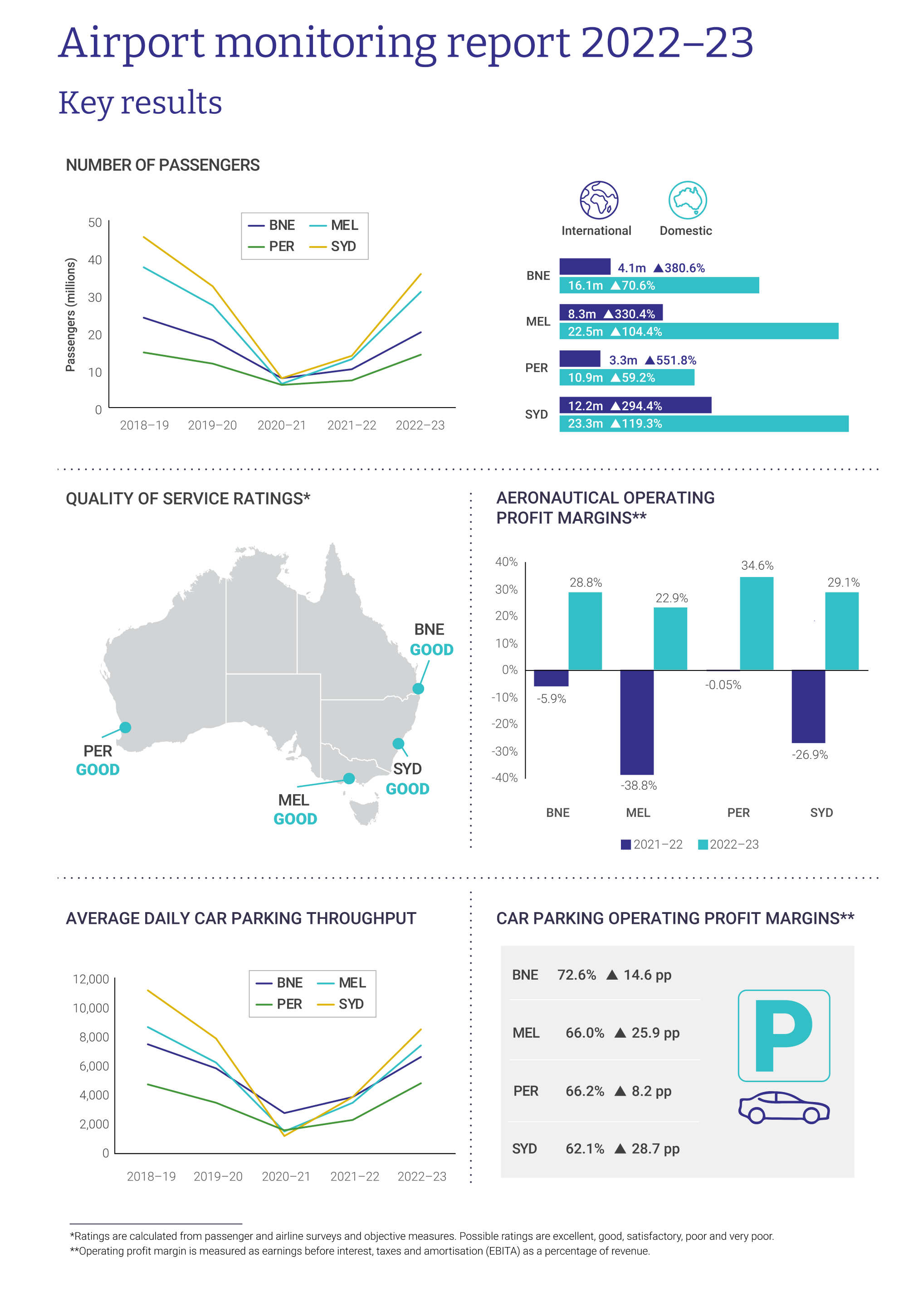The aeronautical operations of Brisbane, Melbourne, Perth and Sydney airports returned to profit in 2022-23, the first full financial year since the end of COVID-19 travel restrictions, the ACCC’s latest Airport Monitoring Report shows.
In contrast, all four monitored airports reported losses on their aeronautical operations in 2021-22.
The four airports reported a total of 100.7 million passengers passing through in 2022-23, up 127.4 per cent from the previous year. However, the number of domestic passengers was still 10.4 per cent below 2018-19 (pre-pandemic) levels, and international passengers 31 per cent below.
“Australia’s four largest airports reported a significant increase in aeronautical revenues and a return to aeronautical operating profits in 2022-23, as interstate and international travel restrictions ended and people returned to the sky,” ACCC Commissioner Anna Brakey said.
“The airports stayed open during the pandemic and continued to incur some aeronautical expenses, without their usual level of accompanying revenues. As passengers returned in 2022-23, aeronautical revenues increased more than expenses, which lifted profit margins closer to pre-pandemic levels.”
Perth Airport recorded an aeronautical operating profit margin of 34.6 per cent in 2022-23, followed by Sydney Airport with 29.1 per cent, Brisbane Airport 28.8 per cent, and Melbourne Airport 22.9 per cent.
Perth Airport’s aeronautical operating profit margin was slightly higher than the 34.2 per cent it recorded in 2018-19, but Sydney, Brisbane and Melbourne’s were lower than 2018-19.
The four airports combined invested $559 million in aeronautical operations in 2022-23, which is a relatively modest amount compared to years prior to the pandemic. Much of this investment was by Melbourne Airport in a range of facilities such as roads, taxiways and terminals.
The airports reported a significant increase in both revenues and operating profits for their car parking operations in 2022-23.
The four airports collectively earned $337 million in operating profits from car parking activities, an increase of 168 per cent on the previous year. All four airports reported operating profit margins above 60 per cent for car parking.
Landside access revenues also increased as more people used taxis, ridesharing services and other types of transport to get to the airport.
The overall quality of service at each of the airports was rated as ‘good’ in 2022-23. The data underpinning the ratings, which is drawn from surveys of passengers and airlines, as well as objective measures of performance, was collected for the first time since the pandemic.
Earlier this year, the ACCC submitted to the government’s Aviation White Paper process that commercial arbitration should be available to resolve any disputes between airports and airlines over airport charges.
“We believe there needs to be greater requirements on airports to provide information to airlines, to address the imbalance of power in commercial negotiations,” Ms Brakey said.
“We have also recommended the Aeronautical Pricing Principles be reviewed, including to make them mandatory and enforceable.”
The Aeronautical Pricing Principles set the framework for addressing prices, service delivery and the conduct of airports in negotiations with airlines.
Background
The ACCC monitors the performance of the four largest airports in relation to aeronautical and car parking services following a direction from the Australian Government requiring it to consider prices, costs and profits. The ACCC also monitors the quality of these services, as well as landside access services.
The possible ratings for airport quality of services are ‘very poor’, ‘poor’, ‘satisfactory’, ‘good’ or ‘excellent’.
Operating profit is measured by earnings before interest, taxes and amortisation (EBITA). Operating profit margin is EBITA as a percentage of revenue.
Aeronautical operations are those that directly relate to the provision of aviation services, including runways, aprons, aerobridges, departure lounges and baggage handling equipment.








